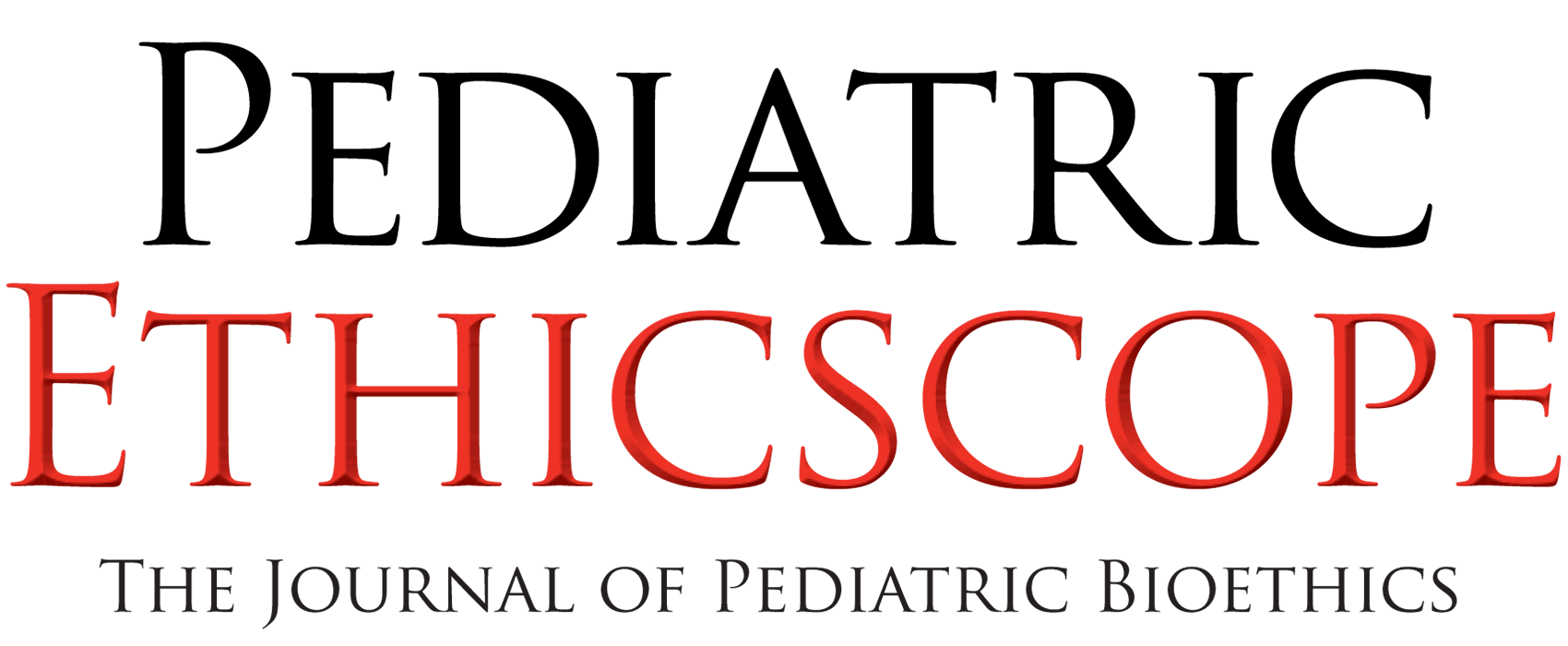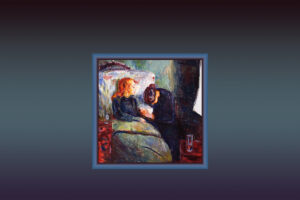Pediatric Ethicscope accepts original research articles, bioethical case analyses, issue analyses and commentaries, short opinion essays, dialogues, interviews, book reviews, and suggestions for the Proem. If you have another idea in mind, contact our editors to discuss. The buttons below lead to downloadable or printable versions of our guidelines, policies, and procedures. Alternatively, these materials can be read online in this window by using the tabs below (additional documentation forthcoming). Once familiar with our policies and guidelines, use our online submission portal to upload your manuscript documents. Contact the editors with any questions.
Pediatric Ethicscope tools for authors:
Journal Scope
Pediatric Ethicscope accepts manuscripts on any subject pertinent to pediatric bioethics or clinical ethics is acceptable in the formats and lengths described below. Subjects can be clinical in nature, policy oriented, or theoretical. Subject matter is evaluated for originality, relevance, and import.
Content Types
Manuscript length is not strictly enforced; a shorter opinion essay or book review may be 500-750 words, a case study 2,000 words, and an in-depth analysis of an issue may be 5,000 words or more. The length should be dictated by what is necessary to treat the issue with sufficient detail that it will inform or educate the reader while remaining concise.
Organization, Formatting, and Style
For initial screening only “Section A. Organization” and “Section B. Formatting Summary,” are required. Manuscripts that pass initial screening and are accepted for technical review will need to meet remaining formatting requirements prior to publication.
A. Organization
Manuscripts should be organized as follows:
- As a separate file, include a Cover sheet that specifies:
- Full title of the manuscript.
- Authors full names beginning with the corresponding author.
- Authors affiliations.
- Full email and mailing contact information for corresponding author.
- The short title.
- A list of six keywords to aid search engines and readers.
- A financial disclosure statement indicating any funding involved with the work.
- A conflict of interest statement indicating whether any authors have potential conflicts of interest.
- Clinical trial registration, if applicable.
- A contributors’ statement indicating which authors were responsible for what parts of the work.
- The Manuscript:
- Should include an abstract of approximately 200 words.
- Should not include personally identifying author information. See Section H below.
- Should include a title and a short title.
- All pages should be numbered.
- When the title alone does not specify the content of the article, subtitles are encouraged.
- All Tables, graphs, images, and graphics should be in separate files, as described below.
B. Formatting Summary
- Single line space between paragraphs.
- Do not indent first line of paragraph.
- Single space between sentences.
- Use section headings to organize longer essays.
- Headings can be numbered and titled or just titled, but try to keep the names short.
- Double space at the end of a section.
- Italicize for emphasis, do not bold.
- Use endnotes for citations, footnotes for scholarly notes.
C. References
Footnotes and endnotes are reserved for specific purposes, and formatted differently. Endnotes are used to cite references, footnotes for scholarly notes. Citations of reference material should be formatted as follows:
- AMA–style as endnotes.
- Non-superscript Arabic numerals.
- Set off in square brackets.
Factual claims should be cited as shown in this example:
For decades, ethics committees have been accepted by both the medical establishment [1] and the civic order [2,3] as the preferred mechanism for resolving ethical issues in medical care. [4] Differing models of ethics consultation have evolved. [5]
_________________
1 American Medical Association. Ethics Committees in Health Care Institutions. Code of Medical Ethics Opinion 10.7. AMA Principles of Medical Ethics: II, IV, VII.https://www.ama-assn.org/delivering-care/ethics/ethics-committees-health-care-institutions. Accessed 6/18/19.
2 Sulmasy DP, Geller G, Levine DM, Faden R. Medical house officers’ knowledge, attitudes, and confidence regarding medical ethics. Arch Intern Med. 1990 Dec; 150(12):2509-13.
3 President’s Commission for the Study of Ethical Problems in Medicine and Biomedical and Behavioral Research. Deciding to forego life‐sustaining treatment: ethical, medical and legal issues in treatment decisions. Washington, D.C.: U.S. Government Printing Office; 1983:160-70, 439-51. https://repository.library.georgetown.edu/bitstream/handle/10822/559344/deciding_to_forego_tx.pdf. Accessed 6/18/19.
4 Annas G, Grodin M. Hospital ethics committees, consultants, and courts. AMA J Ethics. 2016;18(5):554-559. doi: 10.1001/journalofethics.2016.18.5.sect1-1605.
5 Rushton CH, Youngner SJ. Models for ethics consultation: individual, team, or committee? In: Aulisio MP, Arnold RM, Youngner SJ, eds. Ethics Consultation: From Theory to Practice. Johns Hopkins University Press; 2003:88-95.
It is important that authors use the footnote/endnote tools in Microsoft Word. Formatting of endnotes can be adjusted to produce non-superscript numbers. Most manuscripts will also need to make use of the cross–reference capabilities, since references are not repeated in AMA style. The cross–reference feature allows the author to insert additional in-text references to an existing endnote with the same number. This will auto-update if changes are made that would result in renumbering references.
When repeating a citation, if the material cited refers to a different page range than the initial citation, insert the relevant page range as a superscript immediately following the Endnote Reference in the text. This allows readers to easily see that specific parts of a longer text are being referred to:
Conflict of interest in publishing can take many forms. A May 2017 JAMA Editorial took up the issue of conflicts of interest (COI) in medical journal publishing. [1] Some commentators claim that a conflict of interest exists when professional judgment concerning a primary interest may be influenced by a secondary interest. [13-4] Others argue a potential conflict of interest must be differentiated from an actual one. [19-10]
Footnotes are reserved for scholarly notes, and should not be used for citations. Footnotes should be used only if necessary to convey important information that must be made available immediately to the reader, but cannot be done in the document body. Footnotes should be enumerated with superscript lower-case letters:
The new rule codified previously separate regulations from multiple federal agencies.a
_________________
a. HHS regulation 45 CFR part 46 included additional protections for pregnant women, human fetuses and neonates, children, and prisoners.
D. Quotations
There are two types of quotations that can be used in manuscripts. First is an in-line quotation, which is made part of a sentence and is usually quite short. Quotations longer than two lines should be set off in their own paragraphs, indented ½” on both sides. Shorter quotations can be used inline with text using double quotation marks. Here is an example:
A conflict of interest is said to exist, “when professional judgment concerning a primary interest may be influenced by a secondary interest.” [1]
This type of quotation should be cited as shown above. A second type of quotation is that used for passages or entire statements. The following is an example:
A May 2017 JAMA Editorial took up the issue of conflicts of interest (COI) in medical journal publishing. Fontanarosa and Bauchner state:
Conflict of interest (COI) affects every aspect of medicine, including clinical care, teaching, and research. According to one definition, “A conflict of interest exists when professional judgment concerning a primary interest (such as patients’ welfare or the validity of research) may be influenced by a secondary interest (such as financial gain). [1]
The text leading up to the quote should end with a colon (:). On the next line, the quotation begins, ending with its citation. In order to differentiate quotations from the rest of the body text, the quoted text should be indented by .5″ (one-half inch) on both the right and left sides.
E. Charts and Tables
If created in Microsoft Excel, charts and/or tables should be provided as Excel files. Charts and tables not made in Excel should be provided as 300dpi JPG files formatted as indicated below. This preserves the vector information lost in conversion to an image file and allows us to alter the formatting. Contact us to discuss other file types.
All charts and tables should
- Be numbered as: Table 1, Table 2,…, Table n.
- Include a title such as “Table 1: Clinical Ethics Consults by Requesting Unit”
All charts should include a legend.
Charts should be formatted in the Avenir Next font as follows:
- Chart title: Demi Bold 12 pt.
- Chart axis titles: Demi Bold 8 pt.
- Chart graduations: same as above
- Chart data labels: same as above
- Chart legend: Medium 8 pt.
- Chart source: Regular 7pt.
All tables should be formatted in the Avenir Next font as follows:
- Table title: Next Demi Bold 12 pt.
- Data labels: Demi Bold 8 pt.
- Data: Regular 8 pt.
F. Photographs, Illustrations, and Graphics
Inclusion of photographs is encouraged. High quality JPEG, PNG, TIF, or PSD image files are accepted.
Photographic images must be 300 or higher dpi at full size. Do not imbedded the image in the document. Include it in a separate folder with a unique letter identifier. All photographs must include permission of the photographer for use.
Graphic elements are all non-photographic, non-text material; drawings, line art, etc. Graphic elements should be 600 dpi at full size, but exceptionally clean color graphics as low as 300 dpi may be acceptable. All black and white artwork must be a minimum of 600 dpi.
All photos and images should have captions, named with corresponding letter identifiers matching the image file names. The captions may be included in either a separate Word document titled “Captions,” or listed following the manuscript body in the manuscript file.
G. Identification
Both the reviewer and author identities are concealed from one another throughout the review process. Authors should ensure their manuscript submittal packages do not include identifying information except where specified. Besides removal of names and affiliations within the manuscript, confirm these steps have been taken to ensure the manuscript is correctly prepared for double blind peer review:
- Use the third person to refer to work the Authors have previously undertaken, e.g. replace any phrases like “as we have shown before” with “… has been shown before [Anonymous, 2007]”.
- Ensure figures do not contain any author, institution, or related identifier.
- Do not eliminate self-references necessary to substantially support your argument but use a test of necessity to include them.
- In-text citation of works published by the Author should be shown as: ‘[Onym, 2016]’.
- Works published by the Author should be listed in the reference list as: “Onym, 2016. Details omitted for double-blinding.”
- Remove references to funding sources.
- Do not include acknowledgments.
- Remove all identifying information, including author names, from file names and confirm the document properties are anonymized as well.
These efforts will ensure the authorship of the manuscript under consideration is unknown to reviewers.
H. Submittal
The manuscript, coversheet, and any additional files should be emailed to the executive editor, Stowe Locke Teti, at [email protected].
Journal Policies and Procedures
Pediatric Ethicscope subscribes to the highest standards in journal publishing and academic integrity. Since transparency is a core organizing feature of our organization, all journal policies and procedures, including the editors manuscript evaluation process, are publicly available below. Any questions not answered here may be directed to the editors.
Examples for New Authors
Following are three common formats for essays. Yours doesn’t need to be one of these; they are provided as examples of possible formats. If you have specific questions, contact the Pediatric Ethicscope editors at: [email protected].
A. An event from clinical work has caused you to reflect ethically on the situation. This event may have occurred on a repeated basis, or is highly unusual, and you believe this issue needs to be discussed. There may have been a solution or resolution to the situation that other providers might be able use to ameliorate the situation:
- Describe the deidentified event(s) and why there is an ethical issue.
- Explain the ethical issue, drawing on support from the ethics literature or other sources.
- Explain the reasons why this situation arises; what are the contributing factors?
- Describe what you believe would be a better way to address the situation.
- What are the strengths of your proposal? Are there shortcomings? Analyze thestrengths/weaknesses of your proposal, and compare to existing practices or procedures.
- Conclude with a summary of the issue and your analysis.
B. There is a position or belief you hold about an ethical issue, policy, or procedure that you would like to write about. The following is a common format used in bioethics (and other social sciences). It is most commonly used for academically-oriented papers, but could also be used for an in-depth case study:
- Describe the issue. It could be clinical, policy-related, or theoretical.
- Present alternative, well-known points of view on the issue (usually no more than 3) citing therelevant literature.
- Analyze the strengths and/or shortcomings of these points of view.
- Using data, examples, or argument, show how your position solves problems the others donot. Cite other work that supports your argument.
- Draw a conclusion that follows logically from the premises and arguments you presented.
C. If you are interested in writing a case study, this is a common format for medical papers. It consists of four parts: an introduction, case presentation(s), discussion(s), and conclusion. If multiple cases are presented, an additional section summarizing the common elements, or making distinctions, can be placed after the discussion and before the conclusion:
- Introduction: Present your thesis, introduce the case you will be discussing, and summarize the argument you will be making, briefly describing the evidence and conclusion you have made.
- Case presentation: Present one (or more) deidentified cases and include:
- The history: patient, family, psychosocial dynamics, interaction with medical team.
- The ethical issue.
- How the case was managed and the outcome
- Analysis: Analyze the case and outcome; what is important ethically? What lessons are to be learned? How does this relate to your thesis?
- Discussion: Point our commonalities or distinctions in the preceding section. Briefly describe some other well-known points of view, or cite additional support for your thesis.
- Conclusion: synthesize the ideas presented in the previous sections and show how your thesis is supported by the information presented.
D. There are many others! Contact the editors if you have any questions. Thank you for your interest In Pediatric Ethicscope!
E. Additional online resources can be found here:
Reviewer Selection
The choice of manuscript reviewers is an editorial decision, to be made by either the Editor-in-Chief or the Executive Editor, in consultation with the recommendations of the Editorial Board and, as needed, suggestions of the other Journal editors. For purposes of transparency, Pediatric Ethicscope makes public the following policy regarding how reviewers are chosen.
Reviewers shall be chosen based on their knowledge of the matter taken up in the manuscript under review. Reviewers will be selected based on their knowledge of, and expertise with, the material, as well as their ability to provide useful feedback to authors. Following WAME’s Best Practice guidelines, [1] the following should be considered to have potential conflicts of interest:
- Persons who have coauthored work with the author of the manuscript in recent years (10 years).
- Persons working at the same institution as the author of the manuscript.
- Persons who may have a non-financial conflict of interest, such as a known strong position on the topic under consideration in the manuscript.
- Persons who have a potential financial conflict of interest.
Pediatric Ethicscope does not anticipate problems with peer review manipulation in the small world of pediatric ethics. However, to avoid any possibility of such manipulation, author-recommended reviewers will be considered only if the recommended party is known to the Editor-in-Chief or the Executive Editor beforehand, independently of the author of the manuscript under consideration.
While an author may submit a reviewer recommendation, the reviewer’s contact information must be obtained independent of the author to ensure the reviewer’s identity; the contact information of a reviewer should not be obtained from the author of the manuscript under consideration, and the email address should be scrutinized for irregularities.
1. World Association of Medical Editors. Best Practices for Peer Reviewer Selection and Contact to Prevent Peer Review Manipulation by Authors.. http://www.wame.org/about/policy-statements#Best%20Practices%20for%20Peer%20Reviewer%20Selection. April 6, 2015. Accessed 18 July 2017.
_________________________________________________
Authored: 2017.6.22 Stowe Locke Teti
Transparency in Publishing
In keeping with internationally recognized best practices in medical and scholarly journal publishing, Pediatric Ethicscope follows the recommendations of the Committee on Publication Ethics (COPE) delineated in Principles of Transparency and Best Practice in Scholarly Publishing.1 These standards comprise the set of minimum standards for membershipa in:
- Committee on Publication Ethics (COPE)
- The Directory of Open Access Journals (DOAJ)
- The Open Access Scholarly Publishers Association (OASPA)
- The World Association of Medical Editors (WAME)
Adhering to these standards ensures Pediatric Ethicscope operates with the highest integrity, in line with the best and most respected medical and medical ethics publications. The sixteen Principles of Transparency, developed by DOAJ2 are as follows:
Principles of Transparency
1. Peer review process: Journal content must be clearly marked as whether peer reviewed or not. Peer review is defined as obtaining advice on individual manuscripts from reviewers expert in the field who are not part of the journal’s editorial staff. This process, as well as any policies related to the journal’s peer review procedures, shall be clearly described on the journal’s Web site.
2. Governing Body: Journals shall have editorial boards or other governing bodies whose members are recognized experts in the subject areas included within the journal’s scope. The full names and affiliations of the journal’s editors shall be provided on the journal’s Web site.
3. Editorial team/contact information: Journals shall provide the full names and affiliations of the journal’s editors on the journal’s Web site as well as contact information for the editorial office.
4. Author fees: Any fees or charges that are required for manuscript processing and/or publishing materials in the journal shall be clearly stated in a place that is easy for potential authors to find prior to submitting their manuscripts for review or explained to authors before they begin preparing their manuscript for submission.
5. Copyright: Copyright and licensing information shall be clearly described on the journal’s Web site, and licensing terms shall be indicated on all published articles, both HTML and PDFs.
6. Process for identification of and dealing with allegations of research misconduct: Publishers and editors shall take reasonable steps to identify and prevent the publication of papers where research misconduct has occurred, including plagiarism, citation manipulation, and data falsification/fabrication, among others. In no case shall a journal or its editors encourage such misconduct, or knowingly allow such misconduct to take place. In the event that a journal’s publisher or editors are made aware of any allegation of research misconduct relating to a published article in their journal – the publisher or editor shall follow COPE’s guidelines (or equivalent) in dealing with allegations.
7. Ownership and management: Information about the ownership and/or management of a journal shall be clearly indicated on the journal’s Web site. Publishers shall not use organizational or journal names that would mislead potential authors and editors about the nature of the journal’s owner.
8. Web site: A journal’s Web site, including the text that it contains, shall demonstrate that care has been taken to ensure high ethical and professional standards. It must not contain misleading information, including any attempt to mimic another journal/publisher’s site.
9. Name of journal: The Journal name shall be unique and not be one that is easily confused with another journal or that might mislead potential authors and readers about the Journal’s origin or association with other journals.
10. Conflicts of interest: A journal shall have clear policies on handling potential conflicts of interest of editors, authors, and reviewers and the policies should be clearly stated.
11. Access: The way(s) in which the journal and individual articles are available to readers and whether there are associated subscription or pay per view fees shall be stated.
12. Revenue sources: Business models or revenue sources (eg, author fees, subscriptions, advertising, reprints, institutional support, and organizational support) shall be clearly stated or otherwise evident on the journal’s Web site.
13. Advertising: Journals shall state their advertising policy if relevant, including what types of ads will be considered, who makes decisions regarding accepting ads and whether they are linked to content or reader behavior (online only) or are displayed at random.
14. Publishing schedule: The periodicity at which a journal publishes shall be clearly indicated.
15. Archiving: A journal’s plan for electronic backup and preservation of access to the journal content (for example, access to main articles via CLOCKSS or PubMedCentral) in the event a journal is no longer published shall be clearly indicated.
16. Direct marketing: Any direct marketing activities, including solicitation of manuscripts that are conducted on behalf of the journal, shall be appropriate, well targeted, and unobtrusive.
_________________________________________________
Authored: 2017.6.22 Stowe Locke Teti
a. Additional membership criteria may apply. Pediatric Ethicscope editorial staff may consider which, and how many, scholarly organizations warrant membership based on a balancing of managerial decisions and editorial responsibilities.
1. Committee on Publication Ethics. Principles of Transparency and Best Practice in Scholarly Publishing. Version 2. 22 June 2015. Accessed 24 June 2017.
2. Directory of Open Access Journals. Committee on Publication Ethics. Principles of Transparency. https://doaj.org/bestpractice. Accessed 24 June 2017.
Errata, Retractions, and Expressions of Concern
Pediatric Ethicscope follows the opinion expressed in the Council of Science Editors (CSE) white paper, Promoting Integrity in Scientific Journal Publications,1 regarding the publication of errata, retractions, and expressions of concern by readers. That position is as follows:
2.1.8 Errata, Retractions, and Expressions of Concern
Editors have a responsibility to maintain the integrity of the literature by publishing errata or corrections identifying anything of significance, retractions, and expressions of concern as quickly as possible (see section 3.5). When appropriate, they should provide a forum (e.g., letters to the editors) for offering responsible alternative opinions.
Errors in published articles require a published correction or erratum. These corrections should be made in such a way that secondary publication services, such as PubMed, will identify them and associate them with the original publication. Many online journals provide a direct link between the original article and the correction published later.
Editors should monitor the number and types of errors that appear in their journals. This review can be done simultaneously with the evaluation of other journal statistics. Editors should take corrective measures when there is evidence of an increase in preventable errors.
This policy is in line with the World Association of Medical Editors (WAME) Policy Statement on medical editor responsibilities,2 which states editors should:
Promote self-correction in science and participate in efforts to improve the practice of scientific investigation by publishing corrections, retractions, and critiques of published articles, [and] take responsibility for improving the level of scientific investigation and medical writing in the larger community of potential authors and readers.
It is the policy of Pediatric Ethicscope to adhere to these guidelines and recommendations in both print and electronic versions. Contact the Editorial Group through the information provided online with questions or concerns.
_________________________________________________
Authored: 2017.6.22 Stowe Locke Teti
1. Council of Science Editors. White Paper on Promoting Integrity in Scientific Journal Publications. 2.1.8, p. 12. http://www.councilscienceeditors.org/wp-content/uploads/entire_whitepaper.pdf. 2012 Update. Accessed 22 June 2017.
2. World Association of Medical Editors. The Responsibilities of Medical Editors Policy Statement. http://www.wame.org/about/policy-statements#Responsibility%20of%20Editors. Posted 5 August 2003. Accessed 22 June 2017.





